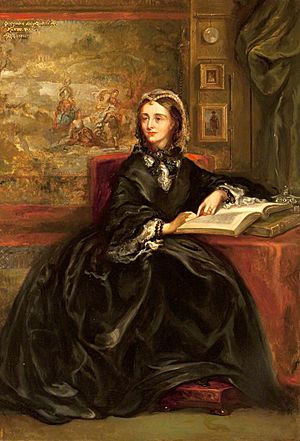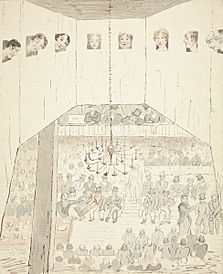Georgiana Chatterton facts for kids
Quick facts for kids
Henrietta Georgiana Marcia Lascelles Chatterton
|
|
|---|---|

Portrait of Lady Chatterton, c. 1859, by her niece Rebecca Orpen
|
|
| Born | 11 November 1806 |
| Died | 6 February 1876 |
| Nationality | British |
Georgiana, Lady Chatterton, was an amazing English writer and traveler. She was born Georgiana Iremonger on November 11, 1806, and passed away on February 6, 1876. Her first travel book, Rambles in the South of Ireland, came out in 1839. Later in life, she became known as Mrs. Dering after her second marriage.
Contents
Life Story of Georgiana Chatterton
Early Life and Family Connections
Henrietta Georgiana Marcia Lascelles Iremonger was born in London on November 11, 1806. She was the only child of Reverend Lascelles Iremonger. He was a prebendary at Winchester Cathedral. Her mother, Harriett Gambier, was the sister of Admiral Lord James Gambier.
Georgiana's family knew many famous people. These included Samuel Johnson, William Wilberforce, and Hannah More. These important figures often visited their home at Barham Court. Georgiana's family traveled a lot. They often stayed with her uncle and aunt, who sometimes had lunch with King George III.
Marriage and Early Writing Career
On August 3, 1824, Georgiana was presented to the King and Queen. This was a formal ceremony for young women of her social class. At her first big party, she met Sir William Abraham Chatterton. He was 18 years older than her. She married him on the same day, August 3, 1824, when she was 17.
They lived in his home in Castle Mahon, Ireland, and also in Winchester. Georgiana often felt unwell while living in Ireland. This led her to move to Florence, Italy. Florence was a city full of new ideas and culture. This move sparked her interest in writing novels. She spent many winters traveling abroad.
Life in London and Literary Success
After her father died, Georgiana and Sir William moved to Mayfair, London. They were very wealthy and often visited King William IV. Georgiana also visited Princess Victoria when she was young.
While living in London, Georgiana wrote her first fiction book. It was called Aunt Dorothy's Tales and was published without her name. Soon after, in 1839, she published Rambles in South Ireland. This book was very popular and sold out quickly. She continued to write new novels every two years. She also enjoyed a busy social life with other writers in London.
Challenges and Second Marriage
From 1845 to 1851, the Great Irish Famine caused problems for her husband. He lost money from his properties. This forced them to move back to England. They lived in Rolls Park in Essex until Sir William Chatterton died on August 5, 1855.
After two years of sadness, Georgiana and Sir William's niece, Rebecca Orpen, started going to parties again. Georgiana then met Edward Heneage Dering, who was also a writer. Edward wanted to marry Rebecca. But Lady Chatterton had poor hearing and thought he was proposing to her! So, on June 1, 1859, the widow Georgiana married Dering.
They later moved to Baddesley Clinton Hall in Warwickshire. Rebecca and her husband, Marmion, also lived there. Marmion and Edward Dering sometimes dressed in old 17th-century clothes.
Later Life and Faith
Within six years of their marriage, Edward Dering became a Catholic. Georgiana thought about it for a while. After talking with William Bernard Ullathorne, a Catholic Bishop, she also converted in August 1875.
Her husband said she lived by three main rules:
- Know what God wants and do it.
- See things exactly as they are, not how she wished them to be.
- Never avoid a problem, even if it was easy to do so.
Georgiana Dering passed away at Baddesley Clinton Hall on February 6, 1876. She was 69 years old. She was a very successful author and left a lot of money. She was buried at the Catholic Church of St Francis of Assisi. Her husband, Edward Dering, and Rebecca and Marmion Ferrers were later buried there too.
Lady Chatterton's Writings
First Books and Popularity
Lady Chatterton's first book was Aunt Dorothy's Tales (1837). It was published in two parts without her name. Two years later, Rambles in the South of Ireland came out. The first edition sold out in just a few weeks. Many other stories, novels, poems, and travel books followed. She used the name Georgiana Chatterton for these. Even with her first two books being very popular, Georgiana often said her books never became "a big hit."
Thoughts on Human Nature
In her novel Allanson, or The Infidel (1843), she wrote about how people might seem different to others. She said, "Most of us try to ignore our own mixed-up feelings. This perhaps makes us less aware of how mixed-up others are." She also wrote about good people who resist bad temptations. And bad people who never do good, even when tempted. Lady Chatterton worked on this book in quiet solitude.
Kindness and Travel Stories
Chatterton's poem "Leonore" (1864) showed her kindness to others. She described how she treated strangers and friends in her writings. She believed that the most pleasant people are those who trust in the goodness of others. By believing in people's good qualities, we help those good feelings come out.
In her book Spain and the Pyrenees, Lady Chatterton wrote about her adventures. She shared observations and told stories from her travels. One story was about a disagreement with the Pope. It explained how marriage was forbidden under threat of being kicked out of the church. Cardinal John Henry Newman praised her deep thinking in her later novels. However, more recently, some people have called her work "unmemorable."
Legacy: Hidden Sketches Found
In 2015, something exciting was found! An expert at the Shakespeare Birthplace Trust discovered a sketch. It was in one of Rebecca Dering's sketchbooks. The drawing was made by Georgiana herself. It was found with two tickets to Westminster Hall from July 11, 1821. This was about nine years before Rebecca Dering was born.
The sketch shows eight women. Their heads are sticking through the windows of the Parliament building. This was while a meeting was happening. Women used to gather above the ceiling to listen. They were not allowed to be present during the sessions. The drawing shows things from Georgiana's view. She could see other women at her level, also looking down.
It's believed Georgiana drew this because of her high social standing. This allowed her to visit Westminster and get tickets to the House of Commons. This drawing is important because it shows how women were involved in politics. Even if they couldn't vote, they found ways to participate. They might listen from a vent in the ceiling. Or they might persuade men to vote for local leaders. Women like Lady Chatterton could influence politics, but only indirectly. They still made a mark on the world. This was almost a hundred years before women could vote in the United Kingdom.


